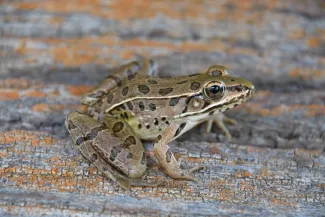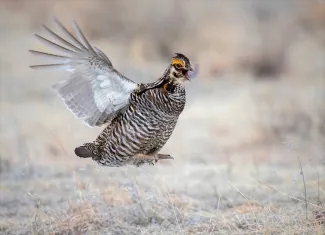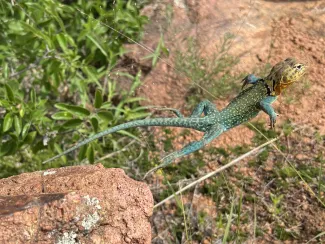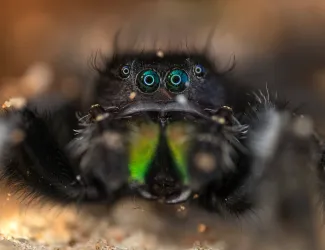A typical calendar year may span 365 days but a solar year – the time it takes Earth to complete its orbit around the sun – really takes 365.25 days. To balance the calendar, a “leap day” is added to the end of February nearly every four years, including 2024, giving nature enthusiasts an extra day to explore Outdoor Oklahoma and observe its incredible fish and wildlife. These four leaping animals are poised to give wildlife watchers an extra look in an extra-long year.
Coastal Plains Leopard Frog
Leopard frogs are some of the earliest frogs to begin calling in the spring and, depending on the temperature, may even be heard chuckling on leap day!

A fully grown Coastal Plains leopard frog is about three inches from snout to vent but its powerful legs can propel it more than 10 times its body length – these leaping animals may cover three to four feet in a single bound! Smaller leopard frogs tend to stay hidden in vegetation closer to water where they can better attempt to escape predators, but larger individuals may venture further from the water’s edge and, if needed, leap to safety with a loud squeal.
The Coastal Plains leopard frog is one of two leopard frogs found in the state. Both species are known for their leaping prowess, are heavily spotted, and have chuckling calls. The Coastal Plains leopard frog is primarily found in eastern Oklahoma and can be identified by the long, intact ridges that run down the back. These ridges are broken and inset near the hind leg of the Plains leopard frog, which is primarily found in western Oklahoma.
Where to Look: Like most other frogs, leopard frogs are closely tied to water. A visit to a local pond, stream, river, or lake may offer the best chance to view these leapers, but they may also be found along wet ditches or around homes with water features. If you don’t have access to the water for a closer view, you can still listen for the frog’s distinctive chuckling calls from public roads. iNaturalist, a free nature observation platform, can point to previous frog sightings and help with identifications.
Greater Prairie-Chicken
These grassland birds will soon be meeting at their local booming grounds where they’ll dance and leap to attract and secure mates.

Each spring, prairie-chickens flock to their traditional mating grounds, often referred to as “leks” or “booming grounds,” where males will leap, stomp, spar, cackle, and boom to defend their territories and attract the attention of potential mates. Though males are the most prominent and aggressive actors of their stage, females will also display by leaping up to two feet in the air while beating their wings rapidly in “flutter dances.”
Two species of prairie-chicken occur in Oklahoma – the slightly larger greater prairie-chicken is found in the state’s more eastern tallgrass prairies and the federally threatened lesser prairie-chicken is found in the state’s more western mixed-grass and shortgrass prairies. Because of these habitat and range gaps, the geographic location of a prairie-chicken sighting is one of the best indicators for identification. Another indicator can be seen on the booming ground: Male greater prairie-chickens tend to have orange air sacs that inflate during their mating ritual while lesser prairie-chickens have more reddish-orange air sacs.
Where to Look: Because of their cryptic coloration and secretive nature outside of the mating season, many birders wait until early spring – when prairie-chickens are most vocal and visible – to add the birds to their watch list. Landowners may offer private access to booming grounds, or you can drive public roads along intact prairies to listen and watch for the booming birds. eBird, a free bird observation sharing site and app, can point to prairie-chicken hotspots and previous sightings.
Eastern Collared Lizard
Oklahoma’s state reptile likely won’t be active until mid-spring, but these leaping lizards can be seen scurrying from rock to rock throughout the summer months.

A mental image of Oklahoma’s state reptile, the eastern collared lizard, will likely include a lot of bold colors, a lot of start-and-stop movement, and a lot of rocks in the background. These rocks are a mainstay of the lizard’s habitat: they burrow under them throughout the winter and then hide among, perch upon, dash across, and leap from rock to rock throughout the summer. These leaping lizards may even run short distances across the rocks on their hind legs, using their long tail for balance!
Eastern collared lizards may not have a close look-alike in Oklahoma, but that doesn’t mean all collared lizards look the same! Female and juvenile lizards have a tan background color and whitish spots, which helps them better blend into their surroundings. Females develop reddish-orange bars on the body at the beginning of the breeding season while juveniles have yellow and orange bars. Breeding males develop a yellow throat and green, heavily spotted bodies. But males in the Wichita and Glass mountains are often darker with blue-green bodies.
Where to Look: These leaping animals can be found in rocky areas across the bulk of the state, except for the extreme southeastern edge. These colorful lizards are most easily observed by slowly driving roads near rocky outcrops – including riprap along man-made dams – and looking along the tops of boulders. iNaturalist, a free nature observation platform, can point to previous lizard sightings and help with identifications.
Bold Jumping Spider
Finding a jumping spider this leap year may only require a trip to your home’s windowsill!

Though small in size, jumping spiders are formidable hunters. They use their eight eyes – two large and forward-facing, and six offering a 360-degree view from the top of the head – to locate their prey. Once their target bug or caterpillar is detected, they make the leap and use their brightly colored mouthparts to subdue their meal. Though jumping spiders don’t build traditional webs, they do spin a silk sanctuary for their eggs and spiderlings and will use a single silk thread as a safety line in case they miss their landing.
A variety of jumping spiders can be found in Oklahoma, but perhaps the most common is the bold jumping spider. These spiders are dark in color, rarely exceed half an inch in length, and have metallic green or blue mouthparts, or chelicerae. Most individuals have a large white or orange spot on the back of the abdomen, which can resemble a heart. Males are often more brightly colored while females tend to have small tufts of hairs above their second pair of eyes.
Where to Look: Sightings of these leaping animals have been reported across the state and individuals can be found from wooded areas to prairies and fields, to homes and other structures. iNaturalist, a free nature observation platform, can point to previous spider sightings and help with identifications.